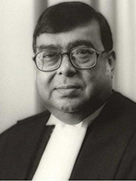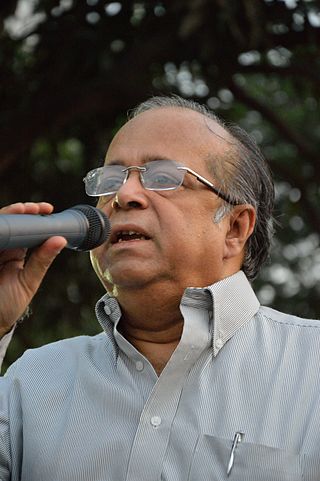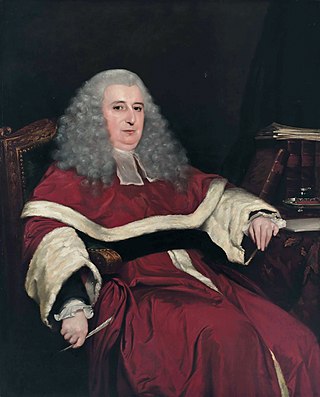
The High Court of Bombay is the high court of the states of Maharashtra and Goa in India, and the union territory of Dadra and Nagar Haveli and Daman and Diu. It is seated primarily at Mumbai, and is one of the oldest high courts in India. The High Court has circuit benches at Nagpur and Aurangabad in Maharashtra and Panaji, the capital of Goa.
The High Court of Delhi was established on 31 October 1966, through the Delhi High Court Act, 1966, with four judges, Chief Justice K.S. Hegde, Justice I. D. Dua, Justice H.R. Khanna and Justice S.K. Kapur. The High Court of Delhi is the Highest Court performing Judicial Functions in the NCT of Delhi at the State level. Below it are the Subordinate Courts, functioning for 9 Judicial Districts namely (1) Central (2) New Delhi (3) South (4) South-West (5) North (6) North-West (7) West (8) North-East (9) East. The High Court of Delhi is the highest judicial organ in a State. It gets its powers from Chapter V in Part VI of the Constitution of India.
The high courts of India are the highest courts of appellate jurisdiction in each state and union territory of India. However, a high court exercises its original civil and criminal jurisdiction only if the subordinate courts are not authorized by law to try such matters for lack of peculiary, territorial jurisdiction. High courts may also enjoy original jurisdiction in certain matters, if so designated specially by the constitution, a state or union law.

Allahabad High Court, officially known as High Court of Judicature at Allahabad, is the high court based in the city of Prayagraj, formerly known as Allahabad, that has jurisdiction over the Indian state of Uttar Pradesh. It was established on 17 March 1866, making it one of the oldest high courts to be established in India.

The Patna High Court is the High Court of the state of Bihar. It was established on 3 February 1916 and later affiliated under the Government of India Act 1915.

The Government of West Bengal, also known as the West BengalGovernment, is the principal administrative authority of the Indian state of West Bengal, created by the National Constitution as the state's legislative, executive and judicial authority. The Governor acts as the head of state and is the highest nominal authority of the state power, however, it is the Chief Minister who is the chief executive authority and head of government.

Sabyasachi Mukharji was an Indian jurist, who was the twentieth Chief Justice of India. He also previously served as the acting Chief Justice of the Calcutta High Court.

Altamas Kabir was an Indian lawyer and judge who served as the 39th Chief Justice of India.

Asok Kumar Ganguly is an Indian jurist. He served as the chairman of the West Bengal Human Rights Commission and as a judge of the Supreme Court of India who delivered judgements in some high-profile cases like the 2G spectrum case.

Dipankar Datta is a judge of the Supreme Court of India. He is the former chief justice of the Bombay High Court and a judge of the Calcutta High Court.

Pinaki Chandra Ghose was the first Lokpal of India serving from 23 March 2019 to 27 May 2022. He is a retired judge of the Supreme Court of India.

The Supreme Court of Judicature at Fort William in Calcutta, was founded in 1774 by the Regulating Act of 1773. It replaced the Mayor's Court of Calcutta and was British India's highest court from 1774 until 1862, when the High Court of Calcutta was established by the Indian High Courts Act 1861.

John Hyde was a Puisne Judge on the Supreme Court of Judicature at Fort William in Bengal from 1774 to his death. He is the primary author of Hyde's Notebooks, a series of 74 notebooks that are a trove of information for the first years of the Supreme Court of Judicature at Fort William, the highest court in Bengal from 1774 to 1862. The originals of these are kept at the Victoria Memorial in Kolkata. Partial microfilms are held at the National Library of India, Kolkata. The digitized microfilm is available online. The originals, which vary slightly from the microfilm, were digitized in 2015 but are not yet released.

The Department of Law, University of Calcutta, Kolkata, West Bengal, formerly University College of Law, is a faculty in the University of Calcutta, founded in 1909, colloquially referred to as Hazra Law College, which offers undergraduate, postgraduate, doctorate and post doctorate courses. The Faculty oversees fifteen affiliated Law schools of the University.
Madhumati Mitra is a former judge of the Calcutta High Court, in West Bengal, India. She briefly served as the registrar of the National University of Juridical Sciences as well as of the Calcutta High Court before being appointed as a judge at the High Court. During her tenure as a High Court judge, she adjudicated in a number of significant cases, including in litigation concerning the Saradha Group financial scandal.

The Madras High Court is a High Court in India. It has appellate jurisdiction over the state of Tamil Nadu and the union territory of Puducherry. It is located in Chennai, and is the third oldest high court of India after the Calcutta High Court in Kolkata and Bombay High Court in Mumbai. The Madras High Court is one of four charter high courts of colonial India established in the four Presidency Towns of Madras, Bombay, Allahabad and Calcutta by letters patent granted by Queen Victoria, dated 26 June 1862. It exercises original jurisdiction over the city of Chennai, as well as extraordinary original jurisdiction, civil and criminal, under the letters patent and special original jurisdiction for the issue of writs under the Constitution of India. Covering 107 acres, the court complex is one of the largest in the world, second only to the Supreme Court of the United Kingdom. The four-storey administrative building attracts hundreds of litigants every day.
Sambhu Chandra Ghose, M.A, LL.B. was the Chief Justice of the Calcutta High Court from 1981 to 1983. He became the Chief Justice after Hon'ble Justice Amarendra Nath Sen. His son Justice Pinaki Chandra Ghose was the first Lokpal and former Judge of Supreme Court of India.
















